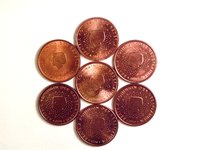Christine Bachoc (Université Bordeaux) and Frank Vallentin (Centrum voor Wiskunde en Informatica, Amsterdam), have found new upper bounds for 'kissing' in higher dimensions. In geometry the kissing number is the maximum number of non-overlapping unit balls that can simultaneously touch a central unit ball. In two dimensions the kissing number is six. You can clearly see this if you group euro coins around one central euro coin. The kissing number is only known for the dimensions 1, 2, 3, 4, 8 and 24. For the dimensions 5, 6, 7, 9 and 10 Bachoc and Vallentin now found sharper upper bounds. On Friday 24 November Frank Vallentin will give a lecture on this subject at the Centrum voor Wiskunde en Informatica in Amsterdam.
The kissing problem has a rich history. In 1694 Isaac Newton and David Gregory had a famous discussion about the kissing number in three dimensions. Gregory thought thirteen balls could fit while Newton believed the limit was twelve. Only in 1953, Schütte and Van der Waerden proved Newton right. In the seventies Delsarte developed a method to determine upper bounds for the kissing number based on linear programming. For four dimensions, for instance, the Delsarte bound is 25, while the exact kissing number is 24. Musin proved this in 2003.

The kissing number in two dimensions.Picture: CWI.
Bachoc and Vallentin developed a new method to determine upper bounds for the kissing number, based on representation theory and semidefinite programming. They found the best known upper bounds for all dimensions up to dimension 10. For dimensions 3, 4, 8 and 24 they again found the exact kissing number. For five dimensions they sharpened the upper bound from 45 to 44, while, for instance in ten dimensions, it turned out that 27 less balls were able to kiss. For their method the researchers used results from Spinoza Prize winner Lex Schrijver. In August they released an article explaining their results on the internet archive arxiv.org. Research on kissing numbers has applications in geometry, error correcting codes in telecommunications, and string theory.
More information
- the article
